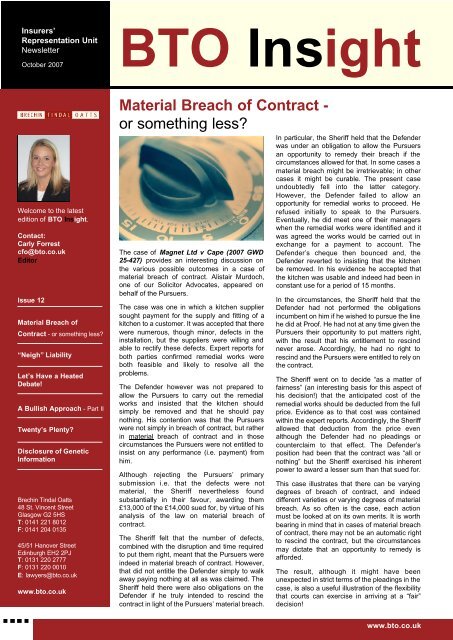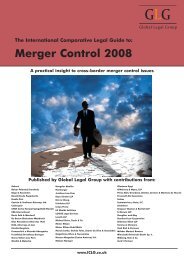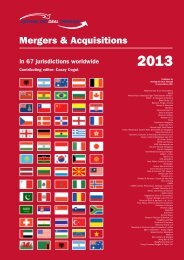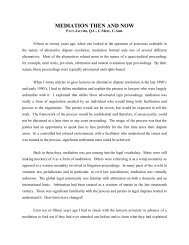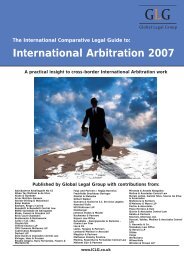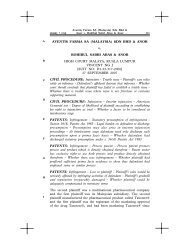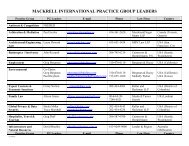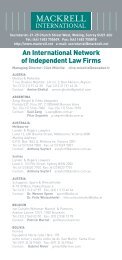BTO Insight
BTO Insight
BTO Insight
Create successful ePaper yourself
Turn your PDF publications into a flip-book with our unique Google optimized e-Paper software.
Insurers’<br />
Representation Unit<br />
Newsletter<br />
October 2007<br />
<strong>BTO</strong> <strong>Insight</strong><br />
Welcome to the latest<br />
edition of <strong>BTO</strong> <strong>Insight</strong>.<br />
Contact:<br />
Carly Forrest<br />
cfo@bto.co.uk<br />
Editor<br />
Issue 12<br />
Material Breach of<br />
Contract - or something less?<br />
“Neigh” Liability<br />
Let’s Have a Heated<br />
Debate!<br />
A Bullish Approach - Part II<br />
Twenty’s Plenty?<br />
Disclosure of Genetic<br />
Information<br />
Brechin Tindal Oatts<br />
48 St. Vincent Street<br />
Glasgow G2 5HS<br />
T: 0141 221 8012<br />
F: 0141 204 0135<br />
45/51 Hanover Street<br />
Edinburgh EH2 2PJ<br />
T: 0131 220 2777<br />
F: 0131 220 0010<br />
E: lawyers@bto.co.uk<br />
www.bto.co.uk<br />
Material Breach of Contract -<br />
or something less?<br />
The case of Magnet Ltd v Cape (2007 GWD<br />
25-427) provides an interesting discussion on<br />
the various possible outcomes in a case of<br />
material breach of contract. Alistair Murdoch,<br />
one of our Solicitor Advocates, appeared on<br />
behalf of the Pursuers.<br />
The case was one in which a kitchen supplier<br />
sought payment for the supply and fitting of a<br />
kitchen to a customer. It was accepted that there<br />
were numerous, though minor, defects in the<br />
installation, but the suppliers were willing and<br />
able to rectify these defects. Expert reports for<br />
both parties confirmed remedial works were<br />
both feasible and likely to resolve all the<br />
problems.<br />
The Defender however was not prepared to<br />
allow the Pursuers to carry out the remedial<br />
works and insisted that the kitchen should<br />
simply be removed and that he should pay<br />
nothing. His contention was that the Pursuers<br />
were not simply in breach of contract, but rather<br />
in material breach of contract and in those<br />
circumstances the Pursuers were not entitled to<br />
insist on any performance (i.e. payment) from<br />
him.<br />
Although rejecting the Pursuers’ primary<br />
submission i.e. that the defects were not<br />
material, the Sheriff nevertheless found<br />
substantially in their favour, awarding them<br />
£13,000 of the £14,000 sued for, by virtue of his<br />
analysis of the law on material breach of<br />
contract.<br />
The Sheriff felt that the number of defects,<br />
combined with the disruption and time required<br />
to put them right, meant that the Pursuers were<br />
indeed in material breach of contract. However,<br />
that did not entitle the Defender simply to walk<br />
away paying nothing at all as was claimed. The<br />
Sheriff held there were also obligations on the<br />
Defender if he truly intended to rescind the<br />
contract in light of the Pursuers’ material breach.<br />
In particular, the Sheriff held that the Defender<br />
was under an obligation to allow the Pursuers<br />
an opportunity to remedy their breach if the<br />
circumstances allowed for that. In some cases a<br />
material breach might be irretrievable; in other<br />
cases it might be curable. The present case<br />
undoubtedly fell into the latter category.<br />
However, the Defender failed to allow an<br />
opportunity for remedial works to proceed. He<br />
refused initially to speak to the Pursuers.<br />
Eventually, he did meet one of their managers<br />
when the remedial works were identified and it<br />
was agreed the works would be carried out in<br />
exchange for a payment to account. The<br />
Defender’s cheque then bounced and, the<br />
Defender reverted to insisting that the kitchen<br />
be removed. In his evidence he accepted that<br />
the kitchen was usable and indeed had been in<br />
constant use for a period of 15 months.<br />
In the circumstances, the Sheriff held that the<br />
Defender had not performed the obligations<br />
incumbent on him if he wished to pursue the line<br />
he did at Proof. He had not at any time given the<br />
Pursuers their opportunity to put matters right,<br />
with the result that his entitlement to rescind<br />
never arose. Accordingly, he had no right to<br />
rescind and the Pursuers were entitled to rely on<br />
the contract.<br />
The Sheriff went on to decide “as a matter of<br />
fairness” (an interesting basis for this aspect of<br />
his decision!) that the anticipated cost of the<br />
remedial works should be deducted from the full<br />
price. Evidence as to that cost was contained<br />
within the expert reports. Accordingly, the Sheriff<br />
allowed that deduction from the price even<br />
although the Defender had no pleadings or<br />
counterclaim to that effect. The Defender’s<br />
position had been that the contract was “all or<br />
nothing” but the Sheriff exercised his inherent<br />
power to award a lesser sum than that sued for.<br />
This case illustrates that there can be varying<br />
degrees of breach of contract, and indeed<br />
different varieties or varying degrees of material<br />
breach. As so often is the case, each action<br />
must be looked at on its own merits. It is worth<br />
bearing in mind that in cases of material breach<br />
of contract, there may not be an automatic right<br />
to rescind the contract, but the circumstances<br />
may dictate that an opportunity to remedy is<br />
afforded.<br />
The result, although it might have been<br />
unexpected in strict terms of the pleadings in the<br />
case, is also a useful illustration of the flexibility<br />
that courts can exercise in arriving at a “fair”<br />
decision!<br />
www.bto.co.uk
“Neigh” Liability<br />
2. If a more capable horse of “Suchard’s” type was placed with<br />
an inexperienced rider, an accident of the type which<br />
occurred was foreseeable.<br />
The riding school denied this and moved the Court to absolve<br />
them of any responsibility. The riding school said that the Court<br />
had to consider whether Mrs McGregor could prove that<br />
“Suchard” should not have been selected for her on that<br />
particular day.<br />
The case of Anne McGregor v LMRS Farm Limited [2007]<br />
CSOH153, called in the Outer House of the Court of Session<br />
recently before Lady Dorrian.<br />
The Pursuer raised an action against a riding school after she<br />
was thrown from a horse during a lesson. She argued that the<br />
riding school were in breach of their duty to take reasonable<br />
care for her safety. This was repudiated by the riding school<br />
and the matter proceeded to Proof. Damages were agreed at<br />
£30,000 and therefore the Proof proceeded on liability alone.<br />
On the day Mrs McGregor was injured she was having her<br />
tenth riding lesson. The first three/four lessons were in basic<br />
beginners and the next five lessons were at a standard level<br />
for beginners (level 2) where the riders learned to trot and<br />
canter. Mrs McGregor had previously been riding a horse<br />
called “Third Time”. On the day of the accident she had moved<br />
up to level 3. The riding school made this decision. Her horse<br />
“Third Time” had gone lame and a different horse “Suchard”<br />
was provided to her. To highlight the difference between each<br />
horse, Mrs McGregor described “Third Time” as being a<br />
reliable Volvo, with “Suchard” being a Ferrari!<br />
The basis of Mrs McGregor’s case was that she should not<br />
have been on that horse in that class on that date. Her<br />
position was that:<br />
1. The horse was accustomed to more advanced riders and<br />
not to inexperienced riders who might give incomplete or<br />
confusing signals to the horse; and<br />
Lady Dorrian was satisfied that the riding school, when making<br />
their decision to use “Suchard”, were aware of the need not to<br />
put a horse that was “too sharp” with a less experienced rider.<br />
Lady Dorrian did not accept that it was negligent to place the<br />
horse with a rider at a lower level just because that horse was<br />
more accustomed to riding at a more advanced level. Mrs<br />
McGregor did not establish that there was such a thing as a<br />
level 2 or level 3 horse. Lady Dorrian accepted that the horse<br />
was well known to the riding school and that it was upon their<br />
assessment of the horse’s temperament and character that<br />
they had based their decision. She accepted that the riding<br />
school had taken the “nature of the horse” into account. The<br />
expert called as a witness for Mrs McGregor said that when<br />
deciding with which horse to place a rider she would have<br />
taken into account factors such as:<br />
1. How the horse had behaved in more advanced lessons;<br />
2. The horse’s sensitivity; and<br />
3. The horse’s degree of obedience.<br />
Lady Dorrian accepted all of these factors had been taken into<br />
account by the riding school. She accepted that Mrs<br />
McGregor had been good for her standard of riding and had<br />
appeared relatively confident at the time. She also accepted<br />
that Mrs McGregor had indicated a willingness to canter on the<br />
horse on that particular day.<br />
It was fortunate that the riding school were able to convince<br />
Lady Dorrian that they knew their horse’s temperament well,<br />
and had taken this into account when making the decision to<br />
place the horse with a rider. On this basis, no damages were<br />
awarded to Mrs McGregor. Lady Dorrian concluded that the<br />
decision to place her on “Suchard” was a reasonable one and<br />
that the riding school were not liable.<br />
.........................................................................................................................................................<br />
Let’s have a heated debate!<br />
The importance of taking some cases to Debate cannot be<br />
underestimated.<br />
In Chinn v Cyclacel in the Court of Session, Lord McEwan<br />
refused Jury Trial and dismissed an action where the Pursuer<br />
was claiming Work Related Upper Limb Disorder, agreeing that<br />
the Pursuer’s pleadings were “misconceived and totally<br />
confused”. In particular, the Pursuer had failed to properly<br />
specify “any recognisable injury” describing her condition in<br />
three alternatives. The decision can be seen at<br />
http://www.scotcourts.gov.uk/opinions/2007csoh142.html. The<br />
Pursuer has reclaimed.<br />
For further information, contact Stephen Bryceland<br />
sbr@bto.co.uk
A Bullish Approach: Part II<br />
In the July edition of <strong>Insight</strong>, we reported on the case of<br />
Michael Davidson v John McIrvine, Aberdeen Sheriff<br />
Court, 19 February 2007, in which the Pursuer failed in his<br />
action against the owner of a bull which had escaped onto the<br />
road. The Pursuer collided with the bull and sustained injuries<br />
as a result. The Defenders were held to be not at fault.<br />
However, the Pursuer appealed against the Sheriff’s decision.<br />
The Pursuer submitted that three new findings in fact should<br />
be added to those made by the Sheriff: a) the Defenders were<br />
aware that bulls could jump over fences of up to eight feet,<br />
which was twice the height of the fences in operation, b) the<br />
Defenders were aware that bulls and other animals often<br />
escaped to the road by running through the Defender’s farm<br />
and the Defender himself was often required to put them back<br />
into the field and c) bulls kept out on their own such as this<br />
often escaped to seek out cattle.<br />
The Sheriff Principal upheld the Sheriff’s decision and refused<br />
the appeal. He held firstly that it would not be right to add the<br />
proposed finding in fact a) without adding a qualification that it<br />
would be virtually impossible for a bull to jump over a fence of<br />
up to eight feet in height. He felt the proposed finding in fact<br />
b) was misleading because it was clear from the evidence that<br />
.........................................................................................................................................................<br />
Twenty’s Plenty?<br />
the Pursuer was referring to other people’s bulls and also the<br />
route taken by these bulls was not stated. In relation to c) it<br />
was an overstatement to say that bulls kept on their own would<br />
“often escape and seek out nearby cattle”.<br />
The Sheriff Principal went on to say that even if the additional<br />
findings in fact had been accepted, a further finding in fact that<br />
it was reasonably foreseeable that if the bull escaped from the<br />
barn it would end up on the road, would not have been added.<br />
The appeal was therefore refused.<br />
This decision reaffirms the views set out in our July edition that<br />
for a Pursuer to succeed with this type of claim at Common<br />
Law, he must be able to establish three key points:<br />
• Did the Defender owe the Pursuer a duty of care?<br />
• Was this duty breached?<br />
• Was the accident a reasonably foreseeable consequence<br />
of that breach?<br />
As demonstrated by this case, if the Pursuer is unable to<br />
satisfy the Court on these key points, his claim is unlikely to<br />
succeed.<br />
In the case of Morag Lawson v the Broomfield Holiday<br />
Park, Dingwall Sheriff Court, 13 July 2007, the Pursuer raised<br />
an action for damages in respect of injury she sustained when<br />
she tripped over a speed bump on the roadway leading to the<br />
holiday park. The accident occurred at night and there was no<br />
pavement she could have walked on.<br />
The Pursuer’s case was based on Common Law and the<br />
Occupiers’ Liability (Scotland) Act 1960. She claimed the<br />
Defenders had failed to demonstrate reasonable care for her<br />
safety as the speed bump represented a hazard which<br />
presented a reasonably foreseeable risk of injury to<br />
pedestrians. She also claimed the lighting was inadequate and<br />
insufficient for pedestrians to see where they were walking,<br />
and that there was insufficient warning of the hazard itself.<br />
Although the word ‘slow’ was painted on the hump, this was on<br />
the side which was facing away from her. In any event, she<br />
claimed the lettering was worn, barely visible and not visible at<br />
all in low lighting.<br />
The Sheriff found that liability had been established against the<br />
Defender. He preferred the Pursuer’s evidence on almost<br />
every issue. However, this was due in no small part to<br />
credibility issues in relation to the Defenders’ main witness, the<br />
tenant and operator of the holiday park. He gave evidence that<br />
photographs he had taken after repainting the ‘slow’ sign some<br />
weeks after the accident showed the hump in the same<br />
condition as it had been at the time of the accident. The Sheriff<br />
had no hesitation in finding that this witness had deliberately<br />
misled the Court and this had a grave effect on the amount of<br />
credit which could be placed on his evidence regarding other<br />
issues such as the adequacy of the lighting.<br />
The Court did, however, make a finding of 20% contributory<br />
negligence. In coming to this view, the Court had regard to<br />
three significant factors:<br />
• The Pursuer was aware of two speed bumps on the<br />
roadway as she had passed over them earlier when she<br />
and her husband drove into the site;<br />
• Although her route was initially illuminated by light from the<br />
reception building she ought to have taken more care for<br />
her safety in the knowledge that there were speed bumps<br />
there;<br />
• It would have been reasonable in the circumstances for her<br />
to have carried a torch or even returned to her camper van<br />
to collect a torch.<br />
The Pursuer submitted there should be no finding of<br />
contributory negligence as she was not well acquainted with<br />
the site, she had not previously passed over the bump on foot<br />
and could not reasonably have been expected to remember it,<br />
or its location, simply through passing over it as a passenger<br />
in a camper van.<br />
Although the finding of contributory negligence may have<br />
provided some small consolation to the Defenders, this case<br />
serves as a warning to consider fully the credibility and<br />
reliability of important witnesses before making the decision to<br />
proceed to Proof.<br />
It was held that the lighting was inadequate and that there<br />
were a number of reasonable precautions which the Defender<br />
could have taken, such as illuminating the speed bump,<br />
erecting warning signs or painting the bump in bright colours to<br />
alert pedestrians to its presence.
Disclosure of Genetic Information<br />
The potential use of genetic information in<br />
assessing risk and the level of premiums<br />
remains an unresolved issue for the<br />
insurance industry. Here we identify some<br />
key arguments and the approaches taken<br />
in various jurisdictions.<br />
Taking a strictly legal view, an insurance<br />
contract is a contract uberrima fides, i.e. in<br />
the utmost good faith, which means that<br />
any information having a bearing on the<br />
assessment of risk must be disclosed to<br />
the insurer. That obligation however is<br />
often restricted to specific disclosures in the proposal.<br />
Currently in the UK, there is a moratorium until 2011 on the<br />
right of insurers to require disclosure of genetic test results.<br />
One exception to this is the genetic condition Huntington’s<br />
Disease, where insurers can require that the results of genetic<br />
testing be disclosed to them.<br />
Why permit disclosure of genetic information?<br />
If it is accepted that insurers can legitimately seek and obtain<br />
other kinds of health information that predicts insurance risk,<br />
then why should they not seek genetic information that is<br />
predictive in the same way?<br />
If insurers were denied access to any kind of health<br />
information, the industry would only be able to differentiate<br />
premiums according to very general risk markers such as<br />
age, sex, place of residence, occupation, etc. If, however,<br />
insurers are permitted to obtain certain kinds of health<br />
information such as body mass index, cholesterol<br />
concentration, results of a physical examination etc. are there<br />
still any principled reasons for excluding genetic information?.<br />
Genetic information is not special. It is not inherently more<br />
specific, predictive, sensitive, or private than other kinds of<br />
health information.<br />
Presently, insurers can require disclosure of family history. In<br />
reality, such disclosure can amount to genetic information.<br />
Clearly, for some diseases, such as Huntington’s Disease,<br />
premiums are already raised if there is a family history, in<br />
much the same way as it is feared they would be if there was<br />
a positive genetic test.<br />
There is an argument that better knowledge of genetic<br />
susceptibility might actually lead to individuals obtaining<br />
insurance where previously they had been unable to, for<br />
example, where there is a family history of a disease but the<br />
individual is proven not to be at risk.<br />
There may be difficulties in defining what counts as genetic<br />
information. Genetic information can be obtained without<br />
invasive testing. Is taking a family history thus a basic form of<br />
genetic test? The most common genetic test is probably<br />
routine blood typing in hospitals but does that mean that<br />
knowledge of an individual’s blood type is one of the pieces of<br />
knowledge that an insurer may not seek?<br />
It is thought that the requirement of disclosure may deter<br />
people from having genetic tests that are relevant to their<br />
health care. This may well be true, but the same is true for<br />
other health information - similar arguments were made about<br />
HIV testing.<br />
Finally, experts have argued that allowing insurers to use<br />
genetic information is dangerous because a positive test for a<br />
“disease” gene does not mean illness is certain. Uncertainty<br />
exists as to how the industry might use the many genetic<br />
“markers” for common serious diseases such as cancer and<br />
heart disease.<br />
Current position in other countries<br />
Similarly, other countries are considering the impact of<br />
genetic testing on insurance. In the USA, the Senate has<br />
passed the Genetic Information Non-discrimination Act of<br />
2005, which is currently making its way through the legislative<br />
process. This would prohibit discrimination on the basis of<br />
genetic information with regards to insurance and<br />
employment.<br />
In Australia, the Human Genetics Commission of Australia<br />
was set up in 2003 to advise the government, insurers and<br />
the public on matters relating to genetics, including the use of<br />
tests for insurance purposes. Currently, no tests may be taken<br />
for insurance, although current results are used, with written<br />
consent.<br />
Meanwhile, our neighbours in Europe for example, Belgium,<br />
Austria, Denmark, Estonia, France, Luxembourg and Norway<br />
have very strict legislation surrounding genetic information.<br />
Insurers are prohibited from asking questions about previous<br />
genetic testing and they cannot impose a genetic test on an<br />
individual.<br />
In Sweden and the Netherlands, however, a compromise<br />
situation exists in that the use of genetic information is<br />
prohibited only if the sum insured does not exceed £100,000.<br />
The results of the moratorium will be published in 2011. Given<br />
the advances in medical science, it may be only a matter of<br />
time before genetic information will be used to some extent in<br />
determining insurance premiums.<br />
Why preclude disclosure of genetic information?<br />
There is a political argument that unfair discrimination could<br />
arise from false beliefs about genetic information.<br />
Use of complete information (including genetic information) in<br />
underwriting could lead to a situation that is actuarially fair but<br />
socially unfair. Actuaries are, reasonably enough, concerned<br />
that if they are barred from using genetic test information they<br />
will price risks incorrectly. The result could be that the<br />
premiums collected would not cover the payments made and,<br />
in particular, that people would have an incentive to buy<br />
policies to cover risks known to them but unknown to the<br />
insurer.<br />
For more information on:<br />
Breach of Contract: Alistair Murdoch ajm@bto.co.uk<br />
Personal Injury: Louise Hay lmh@bto.co.uk<br />
Occupiers’ Liability: sbr@bto.co.uk<br />
Genetics: Douglas Jessiman dwj@bto.co.uk<br />
Policy Issues: Bill Speirs wscs@bto.co.uk<br />
New Insurance Seminar Programme<br />
commences on Thursday 25 October 2007.<br />
If you wish to receive this newsletter by email or be removed from the mailing list, please email mma@bto.co.uk with your name<br />
and company name, and type in the subject box ‘Email <strong>BTO</strong> <strong>Insight</strong>’ or ‘Remove from <strong>BTO</strong> <strong>Insight</strong> mailing list’. Thank you.<br />
The information in this newsletter is not intended to be relied upon as a definitive statement of the law.


